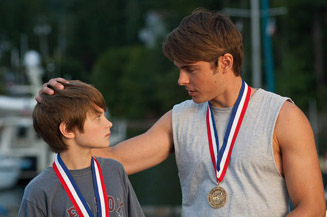|
|
Book vs. Movie: Charlie St. CloudBy Russ BickerstaffAugust 4, 2010
The film rectifies Tess’ anticlimactic coma, moving straight to a scene between she and Charlie in which she comes to realize that those dreams of her with him actually happened. In a final scene, we see Sam meet-up with Charlie one last time. Rather than showing-up as the adult he would never get to be, he shows up again in the same form. He says something along the lines of “we’ll never get to see what will never be.” The two exchange the vow that they will always be brothers and Charlie goes off to meet Tess. The camera pulls away. The credits roll. The Verdict/b> Sherwood’s book makes for an interesting story that isn’t delivered all that well, due in great part to the narrative’s relentlessly wholesome folksiness. The film had the potential to go for a darker, more nuanced take on the story - a potential that it only halfway meets. While the film’s treatment of Sam and Charlie’s relationship seems that much more complex than it does in the book, the romance between Charlie and Tess lacks enough time between the two lovers to develop the kind of complexity necessary for a completely well-rounded presentation of the story. As a result, the romantic end of the film feels a bit flat in comparison to the book. The film’s inability to deliver completely on the romance between Tess and Charlie dooms its chances for commercial success in the long run. Ideally, Charlie St. Cloud should appeal equally to both men and women. The brother-to-brother thing would appeal to men the way the romantic angle would appeal to women. Without enough time spent on the romance to show its complexity, the film misses half its audience - and with so many movies currently in release that appeal to men and so few that appeal to women, the film isn’t going to be that successful. Efron is already bringing quite a few women to theaters, but when they get there, they don’t get nearly enough romance to make it worth the effort in the first place. Research shows that nearly 80% of the opening weekend audience was female. A film with a $44 million production budget has only grossed $12 million its opening weekend. The film is unlikely to be the kind of success the novel has been for Sherwood.
[ View other columns by Russ Bickerstaff ]
[ View other Book vs. Movie columns ]
[ Email this column ]
|

|
|
|

|
Friday, November 1, 2024
© 2024 Box Office Prophets, a division of One Of Us, Inc.


